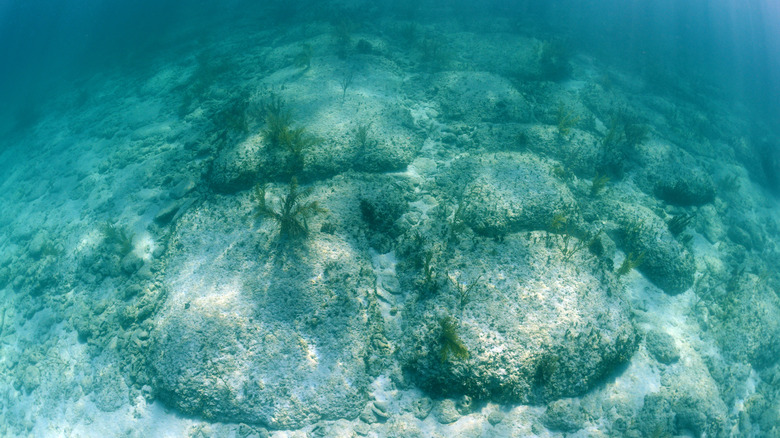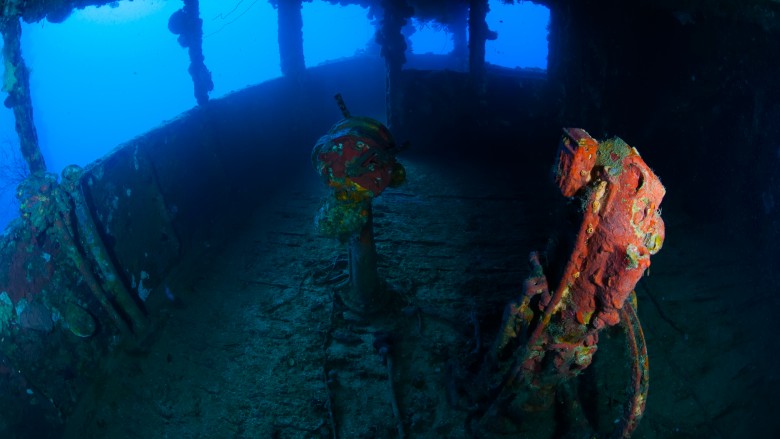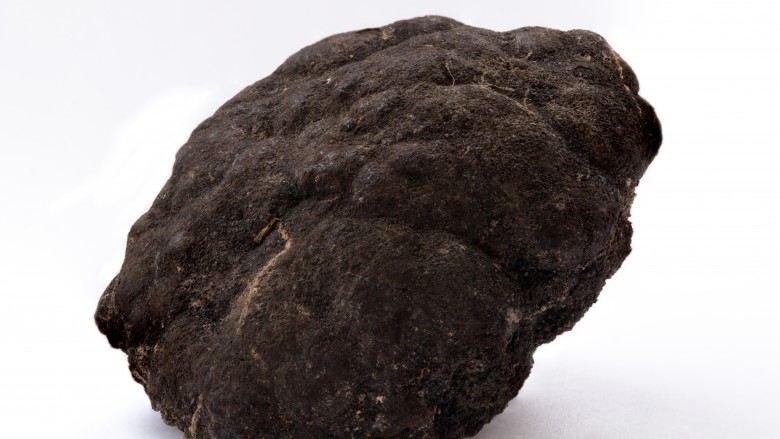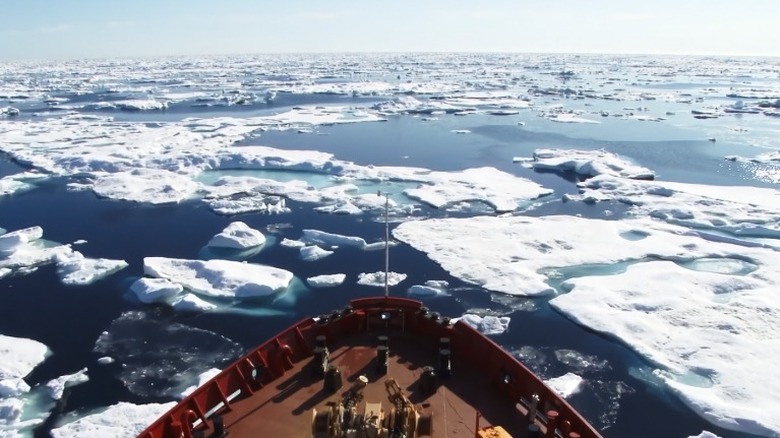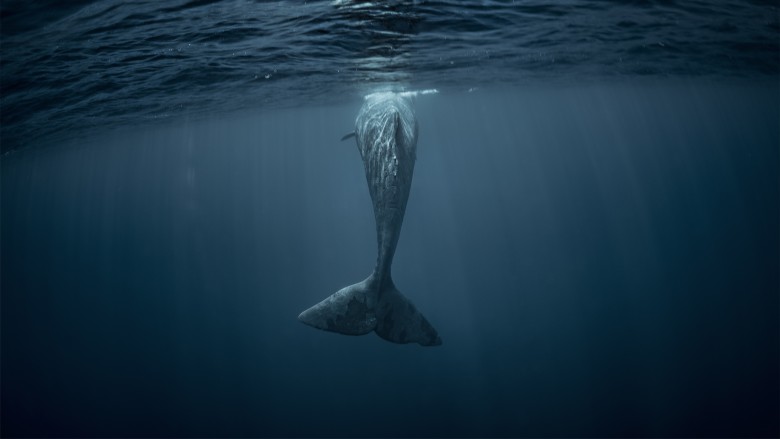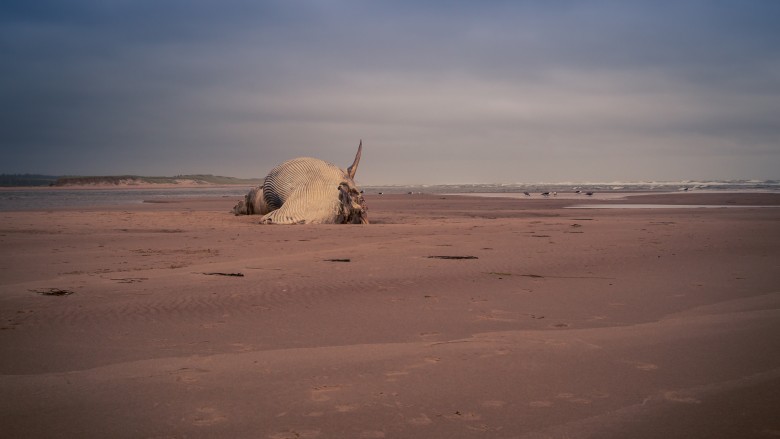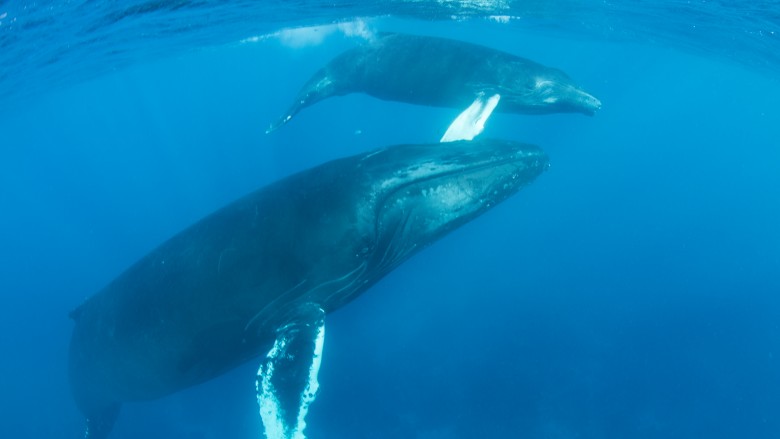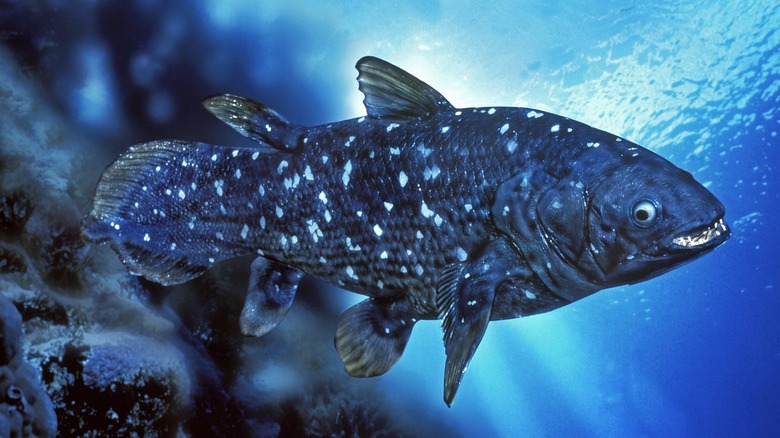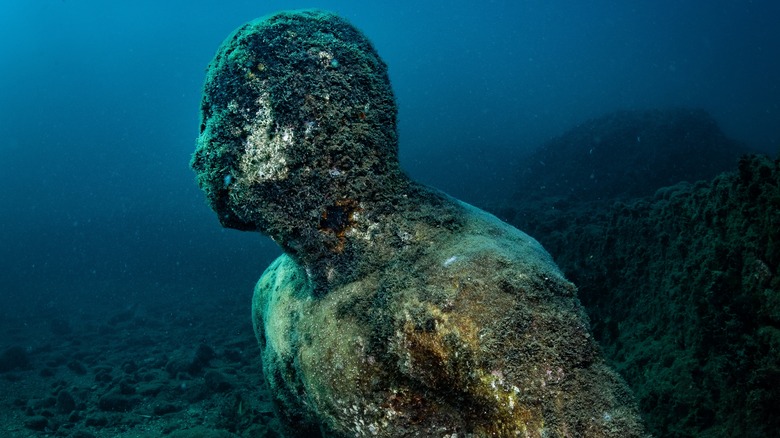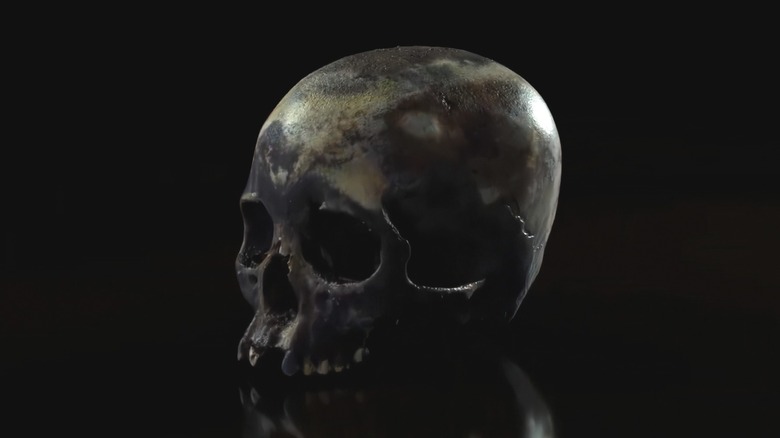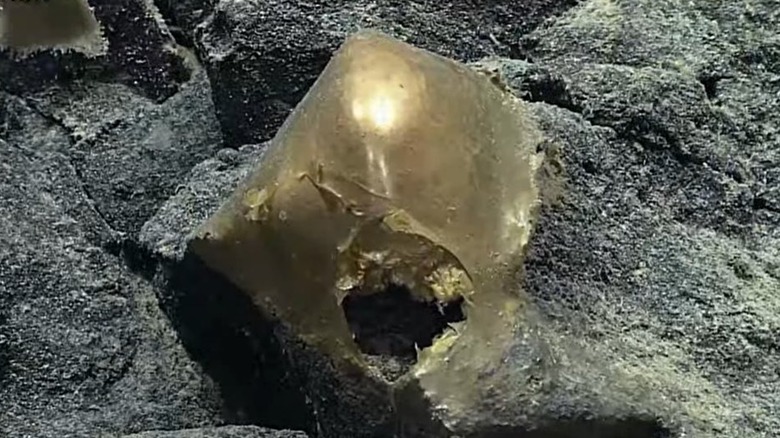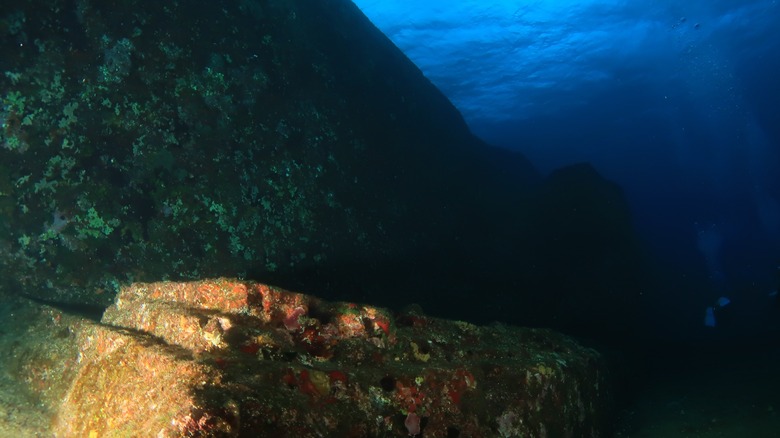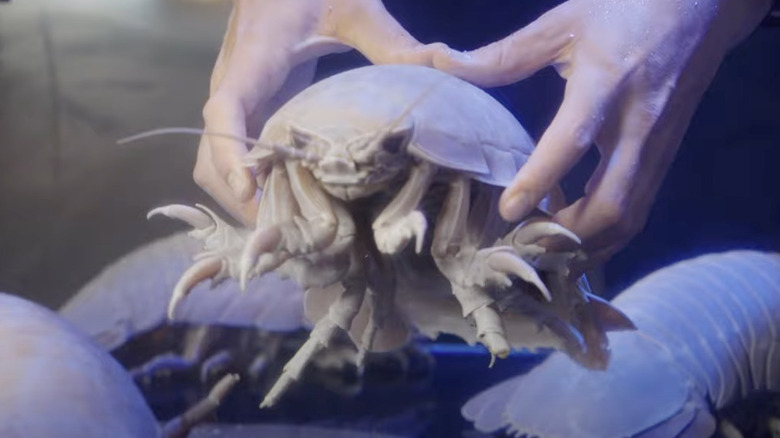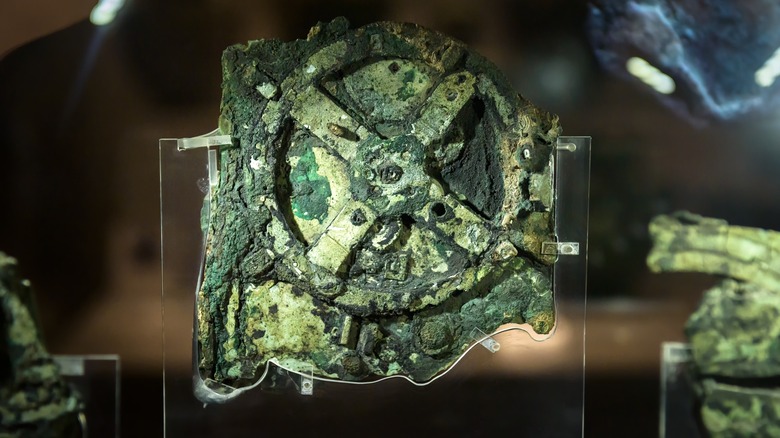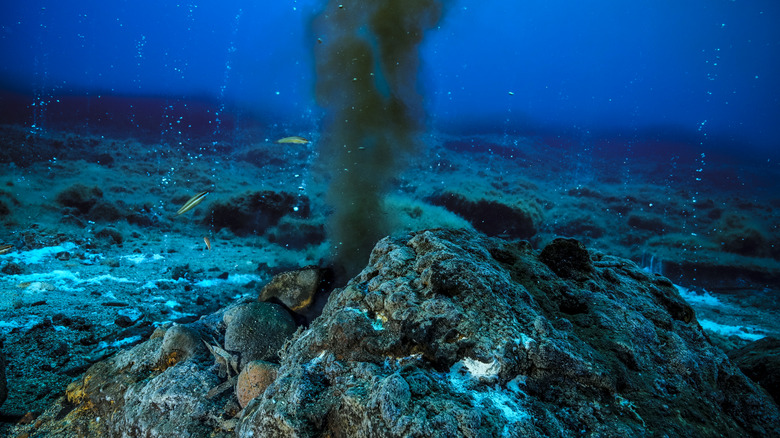Strangest Things People Have Found Underwater
Our world is full of weird and wonderful things, whether they be the remains of strange creatures that roamed the Earth before the dinosaurs or secret tunnels that lead to strange places. But there is one vast repository of mystery that we've barely scratched the surface of, and it lies beneath the waves.
Nearly three-quarters of the Earth's surface is covered in water, whether by icy lakes, shallow seas, or the vast depths of the ocean abyss, and what lies beneath the surface of this watery veil remains largely unknown. In stark contrast to the detailed images of almost the entirety of our planet's landmasses, all of which are at our fingertips to view, humans have only thoroughly mapped a quarter of the world's seafloor, and actually explored a mere 5% of it. Suffice it to say, Earth's vast underwater world has yielded surprise after surprise, and continues to reveal mysteries that are sometimes so strange as to baffle experts and light the public imagination.
From ancient computers to bizarre sounds to lost treasure-bearing fleets and so much more, there have been numerous weird and exotic discoveries made by people underwater. Some of these have upended our understanding of nature and history, many have birthed conspiracy theories ranging from mildly plausible to wildly improbable, while others still leave us scratching our heads in bemusement. No matter where we look, there's something strange in the water, and here are just a few of the strangest found so far.
The Baltic Sea anomaly
In 2011, Swedish diving team Ocean X explored the bottom of the Baltic Sea and discovered something odd: a huge, strange stone disk laying on the bottom of the sea. It was 60 meters wide and basically looked like the Millennium Falcon had plopped down in the Baltic. Plenty of interesting and unusual things have been found at the bottom of the Baltic Sea, but this discovery caused UFO hunters and conspiracy theorists to go nuts.
Theories lit up the internet: UFO believers thought this irrefutable proof that aliens had landed on Earth, as the anomaly just looked too artificial to believe that it was naturally made. It even looked like it had stairs off to the side, and speculation was further inflamed by reports from the researchers that described electromagnetic interference near the object. More grounded theorists thought it was the turret of an old-school battleship or a Nazi anti-submarine mine. But those theories didn't fit with the dating, as it was at least 20,000 years old.
Finally, scientists came along and showed that it was probably a glacial deposit, as geologist Volker Brüchert told Live Science, "Because the whole northern Baltic region is so heavily influenced by glacial thawing processes, both the feature and the rock samples are likely to have formed in connection with glacial and postglacial processes." UFO theorists aren't convinced, though, and are sure there is a government cover-up, while scientists are still arguing about exactly what caused it.
Bimini Road
Off the Bahama islands, there is an ancient road that was mysteriously laid down long ago, or so some people think. Called Bimini Road, this is the speculated route to Atlantis. First discovered in the '60s, Bimini Road is a bunch of stones laid down next to each other, like an underwater cobblestone road. The artifact suddenly starts and ends, implying that it's a small part of a long-lost causeway. However, the big question was: how did it get underwater in the first place? There weren't any large civilizations centered on the Bahamas, so conspiracy theorists though that it was part of an ancient Atlantean highway.
Making things even stranger, the Bimini Road matched a prediction made in 1938 by American mystic Edgar Cayce, who stated (via Ancient Origins): "A portion of the temples may yet be discovered under the slime of ages and sea water near Bimini ... Expect it in '68 or '69 – not so far away." Bimini Road was discovered in 1968.
However, scientists came up with the more reasonable alternate explanation that Bimini Road is just an unusual natural rock formation, after analysis of the rocks showed no evidence of them being cut by tools.
The ghost fleet of Truk Lagoon
By 1944, World War II was going really, really badly for the Japanese. Allied forces had achieved air superiority, and United States bombers could fly all over the Pacific, bombing Japanese ships without much fear of retribution. Nonetheless, the Japanese made the bizarre decision to keep the bulk of their navy in one place: the Truk Lagoon in the Caroline Islands. The Allies launched a massive two-day air raid against the lagoon, after which the Japanese had lost 50 ships and 250 airplanes, which was a huge chunk of their remaining fleet. At the time there was still a war to fight, so the Americans didn't have time to clean up the island and all of the sunken war material got left at the bottom of the ocean.
Divers started re-exploring the lagoon in the '60s, revealing the eerie underwater graveyard with documentary films. The ships, airplanes, and even tanks are in nearly pristine condition and, creepily, most of them still had the bodies of Japanese sailors inside of them. Tourists can now make a dive to the graveyard — the bodies have mercifully been removed — but it's not exactly safe. Ragged metal edges of blasted ships can easily cut through skin, which would be only a minor annoyance if the water's weren't shark infested. But as it happens, they very much are.
The old-school tech has also been leaking toxic oil and fuel into the water for 70 years now. Clearly, the ghost fleet is still trying to fight back.
Underwater rivers
Rivers might not sound like the sort of thing that could exist underwater, but as it turns out, rivers can form underwater given the right combination of water conditions. The biggest and best underwater river is in the Yucatán Peninsula, where at the bottom of the sea there is a thin layer of hydrogen sulfate, which basically acts as a barrier between two layers of water. It's not something a diver will feel when passing through, but it creates a secondary body of water below the proper ocean.
This isn't just some strange formation that divers nicknamed an underwater river, despite not really looking like one. Fallen leaves cover the dirt banks of the river and submerged trees dot the edges; besides being underwater, it looks just like a normal terrestrial river. There's just nothing like it in the world, and the unsettling natural phenomenon looks like a piece of dry land that was submerged by an angry mythical god, without changing anything else.
Upsweep
Various governments around the world run ocean-listening networks that, aside from keeping an ear on other nations' marine movements, are used to study glaciers, volcanic activity, and animal migration. But they have also recorded creepy sounds from the deep that sound like Cthulhu.
The most famous one was "Bloop," which many thought was a mating call by a giant sea monster, but ended up being an ice shelf breaking apart. While Bloop attracted everybody's attention, other mysterious sounds without as much limelight, such as Upsweep, a periodic rising sound that's been picked up since 1991. Unlike other weird noises, Upsweep is periodic and uniform, without the randomness we'd expect from a natural occurrence. And it just keeps showing up, with no explanation. At first, it was thought that Upsweep was the sound of seawater contacting underwater lava, but the sound profile didn't match, nor did the fact that it has been detected over and over like clockwork.
Since 1991, Upsweep has slowly gotten quieter, but it's still audible to underwater hydrophones. Even the official National Oceanic and Atmosphere Administration has no clue why this is happening. Until we know for sure, sea monsters are in the realm of possibility.
Living microbes from the Jurassic period
The oceans are home to many species that haven't really changed for millions of years. But those creatures have nothing on a group of microbes found at the bottom of the ocean who win the survivor award, hands down, having stayed alive since the Jurassic period.
A group of European researchers discovered the extraordinary organisms while digging sediment cores in the ocean. When they analyzed the samples, they found a colony of microbes that seemed barely alive. Further tests showed that the oldest microbes in the colony were 86 million years old, and while buried under a thick layer of ocean sediment had somehow survived all those years without food or sunlight, and with a minimal amount of oxygen to breathe.
The secret to these microbes' incomprehensibly long life is their equally mind-bogglingly slow metabolism. In contrast to common microbes, such as E. Coli that can divide every 17 minutes, the single-celled organisms found by the researchers under the ocean are estimated to take 1,000 years to divide. So without scientific tools to deduce their metabolism and life cycle, you'd have to watch these ancient creatures for 1,000 years to even prove they were alive. It's amazing to think about how much history had passed by the oldest cells in the colony. The discovery shows how resilient single-celled organisms are, adding to the likelihood of finding single-celled life in space.
Apollo 11 engines
Throughout the entire history of lunar exploration, when rockets soared into space during the '60s and '70s, scientists weren't too concerned where the booster engines and other equipment landed when jettisoned. As long as it didn't smash into a residential area, they were fine with it falling somewhere in the ocean. Basically, NASA was a bunch of heartless space litterers.
Rockets parts are scattered among Earth's oceans so it's nearly impossible to find them, but that didn't deter Amazon founder Jeff Bezos. In 2012, he assembled a secret dive team to try to find the F-1 engines that shot the Apollo missions into orbit. But he wasn't just content with any old engines; he wanted the ones from Apollo 11, the mission that landed men on the Moon. After tons of searching, they found them, lying 14,000 feet below the ocean surface.
The engines were in remarkably good shape for hunks of metal that fell from space and slammed into the ocean. Bezos recovered them and quickly contacted NASA, who then claimed legal ownership over the engines they hadn't seen in over 40 years. However, Bezos turned them over without a fuss.
Underwater crop circles
UFO researchers love speculating about crop circles, even though they're almost certainly just pranks pulled by bored rural kids. While the "normal" crop circles aren't especially mysterious anymore, when they started popping up at the bottom of the ocean, they raised more than a few skeptical eyebrows.
Divers off the coast of Japan started seeing the strange patterns in 1995, each one about 7 feet in diameter. For stalwart believers in extraterrestrial visitations, this seemed like another sign aliens were hanging out on Earth, only now they were drawing pictures underwater. As it turns out, the underwater circles are naturally occurring.
The real explanation isn't quite on the same level of weird as aliens, but it is fascinating nonetheless: male pufferfish are the culprits, which spend 10 days creating the circular pattern to impress lady pufferfish. During mating season, the ladies swim around the ocean looking for the coolest circles, then lay their eggs in the middle of the ones they deem to be the best. Nobody knows how the female pufferfish make their decision, but they evidently have extremely refined aesthetic taste. Even after winning the underwater circle dating game, the work of the male pufferfish is not yet done; the female pufferfish doesn't stay around, and he has to raise the eggs. Once they hatch, he doesn't even get to spend time hanging out with the baby fish. Nope, it's simply on to the next patch of sand to build another nest. For his whole life, the male pufferfish is just making circles in the sand.
The mysterious manganese balls of the Atlantic Ocean
Throughout the ocean, there are groups of little manganese nodules hanging out, slowly growing. How they grow isn't too much of a mystery: manganese gets dissolved in the ocean water, and slowly accretes on other clumps of the metal. And slowly is an understatement: The little metal balls grow only 1 centimeter every million years, so they've been around a really long time. Because they're so easy to harvest, mining companies were pumped when they were discovered, and now many of them harvest the metal from the ocean surface.
Finding vast beds of metal balls on the ocean floor is strange enough, but what is even stranger is when they're found in a place that they're not expected to be: the tropical Atlantic ocean. Scientists have yet to confirm how they even formed in the first place, and the 42-day expedition that analyzed the nodules in 2015 was unable to determine their origin. Theorists believe they might have been started by ancient underwater microbes, or they're just a natural result of ancient oceans, which might have been more metallic.
The Fury and Hecla Strait noise
The Fury and Hecla Strait is a body of water in the Qikiqtaaluk Region of Nunavut, Canada, which might be one of the coolest names in the world for a geographic region. The awesome name of the region isn't what makes it famous, though, it's the mysterious sounds coming from the water. All throughout the summer, boatmen on the water hear mysterious humming or pinging sounds. Oddly, the sounds travel only through the water and are audible when they reverberate through the hulls of boats, almost like the ocean is trying to use Canadian boats to send a message to the human race.
Nobody knows why it's happening, though there are a ton of theories going around, most of them blaming Baffinland Iron Mines Corporation mining, Arctic research stations, or Greenpeace conservation efforts involving migrating whales. All the groups connected to the phenomenon made thorough investigations, and yet couldn't find anything they were doing that might create it, which left the locals very creeped out.
Even the military stepped in to try to figure out what was going on, but nothing was discovered. So far, the sounds still remain an utter mystery. Qikiqtaaluk might not have been on anybody's list as a paranormal hotspot, but things are definitely spooky up in the frozen north.
A huge World War II silver deposit
War is an expensive business, and the last thing that England wanted in World War II was to lose to the Nazis just because they were strapped for cash. Before the Internet and global online banking, that meant silver and gold from the Empire had to be loaded onto ships and sailed around the world. That's dangerous work when Nazi U-boats are in the waters.
In 1942, the SS City of Cairo sailed from India with 100 tons of silver coins to help out the war effort. Shockingly, they decided to sail without escort, and — to the surprise of absolutely no one — a U-boat found the ship and blew it to pieces. Oddly, the captain of the submarine appeared to feel so bad about it that he surfaced his boat and, after making inquiries about the ship's cargo and any prisoners of war it might be carrying, yelled to the survivors in lifeboats, "Goodnight, and sorry for sinking you," and disappeared back under the water. Meanwhile, all of that silver bullion sunk to the bottom of the ocean, and the SS City of Cairo joined the multitudes of shipwrecks lost to the ocean.
For decades, well over $50 million of silver at today's prices just sat at the bottom of the ocean, with only the fish around to use it. Finally, it was rediscovered, and the United Kingdom financed a team to grab it, probably with strict orders to take none of the coins for themselves. Upon retrieval, the money was returned to England, where most of it was melted down, although a few thousand were painstakingly restored to be sold to coin collectors.
The giant jellyfish that was inspecting an oil rig
When working on an oil rig, the last thing anybody wants is a giant sea monster to show up. But that's exactly what happened in 2012, when cameras on an oil rig in the Gulf of Mexico picked up something strange. Out of nowhere, a huge amorphous blob of flesh appeared, circled the rig, and disappeared back into the ocean. What was the thing? The video shows a number of details that don't look much like an Earth creature that most people would recognize. The sea monster looked like a big brown sheet of flesh, but had reproductive organs and something that looked like a network of nerves.
While extraterrestrial visitors have been ruled out, the actual explanation is still quite extraordinary. Biologists identified the creature as Deepstaria enigmatica, which may sound like a progressive metal band but is actually a massive jellyfish, although one that looks more like a misshapen blob of brown flesh than the pretty, delicate jellyfish that we see in aquariums. It's rarely seen and usually hangs out in deep water, where it grows to absurd sizes; part of the issue with studying the species is that it's too big for most submersibles to capture one as a sample.
So biologists now know what it was, but why did the jellyfish try to come hang out with an oil rig? They aren't known for friendliness, and they aren't exactly the smartest of creatures. But for some as-yet-unknown reason, this giant specimen took a liking to our oil rig. Hopefully they aren't planning some sort of takeover.
What is the story behind the 52-Hertz whale?
All over the oceans, researchers have underwater listening devices that are designed to track whales. Every whale species has distinctive calls, so whale experts can easily identify what they're listening to. At least, until they heard the 52-Hertz whale. Since 1989, this whale has stumped researchers because it's the only one in existence that calls at that specific frequency.
People tracking the whale — named "52" — say that it always travels alone. They have never heard it with other whales or heard any other whales calling at 52-Hertz. It is possible that 52 is looking for other whales of its species, constantly calling out for some company. Sadly, it appears that no other whales of its species ever hear it, and that 52 is totally alone.
Nobody knows exactly how this happened. It might belong to a totally different species of whale that we haven't identified. If that's the case, the obvious question is where are the other members of his species? It might very well be the last one, which opens a pandora's box of mysteries regarding that species' fate. Even stranger, nobody has ever seen the lonely cetacean; it has only ever been heard, like a ghost in the ocean. One day we might find it, but for now, 52 is an inspirational icon for people who love solitude.
The disappearing island of Bermeja
Sometimes mysteries emerge when explorers don't find something underwater; in this case, an entire island. Bermeja was an island off the coast of Mexico that appeared on maps as far back as the 17th century, but sometime around the 1800s the whole island disappeared. People kept looking for it in its last known location, and the British supposedly found the island in 1844, reporting it a few hundred feet below the ocean surface. However, nobody could verify their claims, and the island became an urban legend before it blew up into a full-blown conspiracy.
Some enterprising researchers uncovered an 1857 map from the United States that featured Bermeja, and Mexican maps and documents included the island up to 1946. According to discovered documents, the Mexican government sent out an expedition to the location in 1997, but reported there was nothing there, and the last known mention of the island is in a 1998 Mexican book.
So what's going on here? If the island existed, it was above the water at least until 1844. In 1997, the Mexican and United States governments agreed to drill for oil off the coast of Mexico, and then poof, the island supposedly stopped existing. A lot of people think the island was deliberately blown up for some nefarious purpose. These aren't just crackpot conspirators, either: Mexican senators are on record pushing this conspiracy theory, although that still wouldn't explain the much older British claim.
NOAA's unexplained sounds
The United States National Oceanic and Atmospheric Administration operates a network of hydrophones that listen for strange noises in the water. They were first put in place to pick up Soviet submarines, but now they also pick up weird noises that sound like alien life or deep-sea monster calls. The best-known one is the Bloop, which sounded like Cthulhu's mating call. Even though Bloop sounded organic, it's most likely the sound of an iceberg breaking in two. Bloop might be the most popular of the NOAA mystery noises, but the other ones are even more interesting.
There's Julia, which creepily sounds like somebody moaning into the hydrophones. The sound is oddly organic, but the NOAA claims it's just ice and nothing that anybody needs to worry about. Another strange one is Train, a constant hum that echoes through the Antarctic and sounds like a — you guessed it — train going over tracks. It's consistent, but the NOAA still hasn't quite figured it out.
Then there's the mysterious sound Whistle, which only happened once. Whistle was also picked up by a single hydrophone, which is particularly unusual because such sounds typically echo throughout the ocean and get picked up by multiple hydrophones. The NOAA says that it was probably an underwater volcano blowing up, which is still a far-from-mundane event.
The Gulf of Alaska whale-pocalypse
In 2015, the Gulf of Alaska experienced a "whale-pocalypse" when thirty carcasses were found, and so far nobody knows what happened. One whale death is a tragedy, but thirty bumping off at once is a mystery. Marine biologists can tell the whales weren't intentionally beaching themselves and were dying in the water first, which means something awful occurred in the waters off of the Gulf of Alaska. Leading theories say a bloom of poisonous algae might have killed the whales, which is terrifying in its own right.
But the idea of seas that suddenly turn poisonous is the most reasonable solution to the problem. There are some crazy conspiracies involving deep-sea killer squids or even interspecies civil war, and oddly, this isn't the first time it has happened, either. The NOAA has recorded 72 similar events involving whales and other marine mammals since 1991, and only a third of them have been solved. The confirmed causes of these mass mortality events include infection, starvation, and, perhaps least surprisingly, human interactions.
All the whales are singing deeper
Over the past few decades, whales have been acting strange: For some reason, whales are singing lower and lower each year. The mysterious behavior isn't restricted to just one group of whales singing deeper; whales around the world are doing the same thing and at the same rate. Whales from different parts of the world are dropping the pitch of their calls at the same time but without being physically around each other. While coordinating between whales on such a wide scale might seem impossible, it appears to be happening quite quickly, too. Some species of whales, blue whales in particular, are now singing several notes lower than how they were singing in the 1960s.
Countless explanations for this change have been proposed by the marine biology community. The leading theory is that since whales are dying off, they have to drop the tone of their calls to make it resonate better in the water, since it has to travel farther to reach another whale. Other marine biologists think the whales are responding to new ocean dynamics or noise pollution, or even that they have developed a new mating strategy.
Lake Michigan's underwater Stonehenge
Stonehenge is mysterious enough as is, but finding another Stonehenge underwater? That's a whole new level of strange. However, that appeared to be what divers found in 2007, and in a place generally not thought of as a very mysterious place: Lake Michigan.
The lake isn't well known for archaeological mysteries, so when divers found a group of standing stones under the water, it was a huge surprise. Upon first examination, the structure looked just like Stonehenge on the British Isles, except it dated back as far as 10,000 BC. Reports abounded that stones had the same familiar circular pattern and even a carving of a mastodon in them. Because they're underwater, they have degraded much more than the above-water British Stonehenge, so the carving has yet to be confirmed, but the other comparisons have faded away as researchers mapped the site.
Underwater scientific research is tricky, but painstaking investigations into Lake Michigan's strange underwater standing stones have revealed that they are arranged in a V-formation, rather than a circle. Surrounded by a wealth of prehistoric hunting artifacts in what was once a rich and fertile region, leading theories state that the stones were part of sophisticated structures designed to corral prey animals such as caribou, in what were effectively prehistoric hunting blinds. During that glacial period, thousands of years ago, the basin of Lake Michigan was dry, before the melting of the great North American ice sheet eventually filled it with water.
The coelacanth
The coelacanth is an ancient species of fish, and an unusual one to boot. It's got singular features like an additional tail lobe, fins that look like human arms and legs when they move, and a semi-developed spinal column. These strikingly blue-colored creatures are also the only animals on Earth with a useful intracranial joint, a hinge that splits the fish's ears and brain from its eyes and nasal passages that lets it lift up the front of its own head to make eating easier. Perhaps the weirdest fact of all is that until the early 20th century, the prevailing scientific wisdom was that the coelacanth had gone extinct 70 million years ago.
In December 1938, one was caught at the top of the Chalumna River in South Africa, captured in a net by a fishing boat. The crew thought it was a strange specimen, and let the closest museum in the town of East London know about it. That facility contacted ichthyologist Dr J.L.B. Smith, who correctly identified the fish as a coelacanth. A subsequent expedition found a small population near the Comoros Islands, between the African mainland and Madagascar.
Sixty years later, a second type of coelacanth was found, this time a brown one, in Sulawesi, Indonesia. A fishing boat scooped it up in 1998, and sold it to a fish market, where a vacationing marine biologist happened to spot it and recognized it. Because of the different color, this was classified as a second species of coelacanth.
The city of Baia
The west coast of Italy is loaded with calderas, large holes left in the Earth by spent volcanos. All that volcanic activity naturally results in mineral water sources and hot springs, and those led to the creation of a resort and wellness retreat known as Baia or Phlegraean Fields ("phlegraean" means "smoking," referring to the preponderance of steam). Built in the second century B.C., Baia became the place where ancient Rome's most rich and powerful went to relax and party. Much debauchery occurred among the villas, spas, pools, and grottos, and prominent figures like Virgil, Cicero, and Pliny kept vacation homes in Baia. It remained an attraction until it was destroyed by an invading army in the eighth century A.D.
All the natural forces that made Baia were also responsible for its demise; hydrothermal and seismic actions slowly pushed the city into the Mediterranean Sea. While there were historical accounts of Baia, its remnants weren't discovered until the 20th century, when in the 1940s an aerial photo captured a glimpse of one of the city's structures about to break through the surface of the water. In the 1960s, the Italian government sent a submarine to explore the sunken city of Baia. Opened as an underwater theme park in 2002, the ruins include rotundas, tiled rooms, and statues.
The remains of one of the first Americans
In 2007, a team of divers decided to explore Hoyo Negro – which appropriately and literally means "black hole" — a cave found 150 feet underwater inside of a submerged cave system in the Yucatan Peninsula in eastern Mexico. Amongst the rocks, plants, sea life, and debris in this very remote spot, the divers also found human remains. The well-preserved skeleton was an almost totally complete bone system of what scientists quickly determined to be a teenage girl.
Seven years after the divers' discovery, the results of the mitochondrial DNA analysis on the bones revealed a lot about who the skeleton belonged to, as well as its anthropological significance. The young woman, named Naia by scientists (after the water nymph of ancient Greek mythology), was 15 to 16 years old when she died, a fate suffered when she fell into a dark pit. Testing indicated that Naia lived about 13,000 years ago, making this skeleton one of the oldest ever found in the Western Hemisphere. Naia shared DNA with some Native American groups currently living in the U.S., but also had genetic material indicating East Asian descent. This links the skeleton to ancestors who crossed over from Asia into the Americas via the Bering Land Bridge, the now-underwater connecting point between Siberia and Alaska.
The golden orb
In August 2023, scientists working with the National Oceanic and Atmospheric Administration's Seascape Alaska 5 expedition dispatched a series of remote-controlled underwater vehicles to explore the seafloor in the Gulf of Alaska. While traversing the extremely deep waters to map the habitats of various ocean creatures, the researchers spotted something on one of the vehicle's cameras, and it was all live-streamed over the internet. They'd come across a burnt-gold item, approximately four inches wide. Variously called an orb or blob, researchers participating in the broadcast theorized that the golden curiosity could be a shed egg casing, a stray piece of coral, or a sponge. What made the object even stranger was the small hole on one side, indicating some living thing crawled into or out of it.
With the help of a suction tool, the orb was retrieved for further study. After thoroughly investigating the thing, the scientists were stumped. "While we were able to collect the 'golden orb' and bring it onto the ship, we still are not able to identify it beyond the fact that it is biological in origin," said Seascape Alaska 5 coordinator Sam Candio in a statement via NOAA. "While somewhat humbling to be stumped by this finding, it serves as a reminder of how little we know about our own planet and how much is left to learn and appreciate about our ocean."
The Yonaguni Monument
In 1987, Kihachiro Aratake, head of tourism for Japan's Yonaguni Island and an avid scuba diver, was looking for a good diving point in the nearby sea. While swimming around, he happened upon a series of unusual rock formations, which appeared to include flat surfaces, symmetrical shapes, roads, stair steps, a spiral staircase, a pyramid, an arch, and even what looked like a stadium. "I realized that this would become a treasure of Yonaguni Island," Aratake told the BBC.
But while the discovery was monumental, it wasn't exactly clear — and still isn't — what Aratake found. Most scientific analysis holds that the monuments are naturally occurring, carved by water over thousands of years. "The rocks of this group are also crisscrossed by numerous sets of parallel, vertically oriented joints in the rock. These joints are natural," according to Robert Schoch of Boston University (via the BBC). Others think differently, including Ryukyu University's Professor Masaaki Kimura, who led the first exploratory expedition of what came to be known as the Yonaguni Monument. "I think it's very difficult to explain away their origin as being purely natural, because of the vast evidence of man's influence on the structures," he said. Aratake personally thinks that the Yonaguni Monument is all that remains of a lost, sunken city built in 12,000 B.C. by the ancient Jōmon civilization.
A supergiant crustacean
Around 2017, a new seafood choice began to appear on the menus of Vietnamese restaurants. Locally nicknamed sea bugs, the 14-legged, foot-long, 2-pound crustacean packs a taste similar to lobster, but it's more closely related to insects like woodlice than it is to familiar seafood choices. A team of crustacean researchers from the National University of Singapore, led by Peter Ng, launched a scientific investigation to determine just what this weird new shellfish-like creature was and where it lived.
After taking four sea bugs from a fish market in Quy Nhon, Vietnam, and thoroughly studying them, Ng's team declared this a heretofore undiscovered and unclassified lifeform. It's a giant isopod, and so far it's only been found in one place in the world; in the waters of the South China Sea surrounding the Spratly Islands. Because it lives primarily in parts of the ocean that are nearly 4,000 feet deep, this giant isopod lives in darkness, and that reminded Ng of Darth Vader, the villain from the "Star Wars" movies. So did the creature's appearance — its head resembles the fictional character's helmet. Hence, Ng and his team named the species Bathynomus vaderi. "I am the biggest 'Star Wars' fan in the team," Ng told New Scientist. "But we all agree that the face of Bathynomus looks so much like Darth Vader that it just had to be named after the Sith Lord."
History's first computer
In 1900, a diver looking for sea sponges swam 150 feet below the surface of the Aegean Sea, near the Greek island of Antikythera. He discovered a shipwreck, and teams of divers and anthropologists over the next year confirmed that it was a shipping vessel bound for Rome, dating to the first century B.C. Researchers recovered priceless treasures of antiquity, including coins, pottery, sculpture, and an unidentifiable box made up of oxidized bronze and wood covered in simple machinery.
It resembled some kind of practical device, but investigators remained largely stymied until the 1970s and 1980s, when imaging technology became sophisticated enough to be used to examine the so-called Antikythera Mechanism. As well as discovering markings in ancient Greek and other various symbols, scientists counted 82 individual pieces in the box, including 35 gears, shafts, axles, and pointers. Theorized to be about a third of a much larger now-lost machine, the Antikythera Mechanism is the earliest analog mechanical computer ever discovered.
The Antikythera Mechanism was likely used in ancient Rome as a calendar and astronomical events guide: Driven by a hand crank, the gears would sync up and move dials around to point to dates and months, while also predicting the sky positions of the sun, moon, and five known planets at the time. Testing indicates that the computer was built in the second century B.C., and its clock-like machinery predates similar tech developed in Europe by 1,000 years.
Black smokers
In 1977, Alvin, the first ever submersible designed for tremendous oceanic depths, carried a group of geologists to an oceanic spreading ridge near the Galapagos Archipelago. Ostensibly looking into a recently noted and unexplained temperature shift, they discovered the cause: naturally formed, chimney-like structures that churned out extremely hot murky mineral water. These vents stood as high as a ten-story building, and started from a depth of more than 8,300 feet.
This marked the first discovery of hydrothermal vents anywhere on the planet. In the Earth's crust layer, minerals dissolve in liquid and get necessarily released through those vents, or "black smokers," where the cold ocean water cools down the black, mineral-rich fluid as it disperses into the sea. Research into the hydrothermal vents would also uncover evidence of life in these very deep and strange parts of the ocean. Because the scorching-hot liquid is so full of valuable nutrients, it's surrounded by lifeforms that use a process called chemosynthesis, allowing them to thrive where no sunlight can penetrate. Instead of a food chain relying on photosynthesis as a foundation, the remarkable ecology of black smokers instead uses chemicals as a source of energy.

